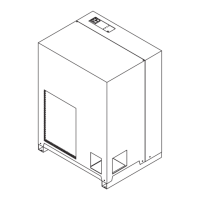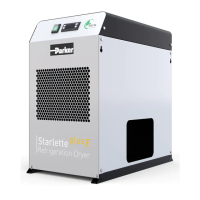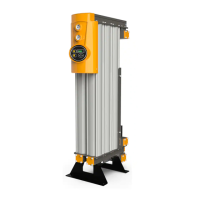200 2
English
2 Introduction
is manual refers to refrigeration dryers designed to guarantee high
quality in the treatment of compressed air.
2.1 Transport
e packed unit must:
• remain upright;
• be protected against atmospheric agents;
• be protected against impacts.
2.2 Handling
Use a fork-li truck suitable for the weight to be li ed, avoiding any type
of impact.
2.3 Inspection
• All the units are assembled, wired, charged with refrigerant and oil
and tested under standard operating conditions in the factory;
• on receiving the machine check its condition: immediately notify
the transport company in case of any damage;
• unpack the unit as close as possible to the place of installation.
2.4 Storage
If several units have to stacked, follow the notes given on the packing.
Keep the unit packed in a clean place protected from damp and bad
weather.
3 Installation
Y For the correct application of the warranty terms, follw the instruc-
tions given in the start-up report, ll it and send it back to Seller.
3.1 Procedures
Install the dryer inside, in a clean area protected from direct atmospher-
ic agents (including sunlight).
In places with re hazard, provide for a suitable re-extinguishing sys-
tem.
Y Comply with the instructions given in par. 8.2 and 8.3.
All dryers must be tted with adequate pre- ltration near the dryer air
inlet. Seller is excluded any obligation of compensation or refund for any
direct or indirect damage caused by its absence
Y Pre- lter element (for 3 micron ltration or better) must be replaced
at least once a year, or sooner as per manufacturer recommendations.
Y Correctly connect the dryer to the compressed air inlet/outlet con-
nections,
3.2 Operating space
Y Leave adequate clearance around the dryer maintenance opera-
tions.
On the condenser side, leave at least 3.94 inches (10 cm) clearance to
ensure correct air ow.
3.3 Versions
Air-cooled version (Ac)
Do not create cooling air recirculation situations. Do not obstruct the
ventilation grilles.
3.4 Tips
To prevent damage to the internal parts of the dryer and air compres-
sor, avoid installations where the surrounding air contains solid and/or
gaseous pollutants (e.g. sulphur, ammonia, chlorine and installations in
marine environments).
e ducting of extracted air is not recommended for versions with axial
fans.
3.5 Electrical connection
Use approved cable in conformity with the local laws and regulations
(for minimum cable section, see par. 8.3). Use copper conductors only,
rated for a temèerature of a least 140°F(60°C).
Install a di erential thermal magnetic circuit breaker with contact open-
ing distance 3 mm ahead of the system (IDn = 0.3A) (see the relevant
current local regulations).
e nominal current In of the magnetic circuit breaker must be equal to
the FLA with an intervention curve type D.
3.6 Condensate drain connection
Y Make the connection to the draining system, avoiding connection
in a closed circuit shared by other pressurized discharge lines. Check the
correct ow of condensate discharges. Dispose of all the condensate in
conformity with current local environmental regulations.
4 Commissioning
4.1 Preliminary checks
Before commissioning the dryer, make sure:
• installation was carried out according that given in the section 8.2;
• the air inlet valves are closed and that there is no air ow through
the dryer;
• the power supply is correct.
4.2 Starting
• Start the dryer before the air compressor;
• switch the power on by turning the MAIN SWITCH
&
to “I ON”
( see par. 5.1 for the meaning of the LEDs).
• a er at least 5 minutes slowly open the air inlet valve and subse-
quently open the air outlet valve: the dryer is now performing its air
drying function
4.3 Operation
• Leave the dryer on during the entire period the air compressor is
working;
• e dryer operates in automatic mode, therefore eld settings are
not required;
• Condensate draining is factory-set in TIMED mode, with max.
permissible opening equal to 10 seconds; the set time can be decrese
(see par. 5.2 for details)
• In the event of unforeseen excess air ows, by-pass to avoid over-
loading the dryer.
• Avoid air inlet temperature uctuations.
4.4 Stop
• Stop the dryer 2 minutes a er the air compressor stops or in any
case a er interruption of the air ow;
• Make sure compressed air does not enter the dryer when the dryer
is disconnected or if an alarm occurs.
• Turn the MAIN SWITCH
&
to “O OFF” to switch the power o .

